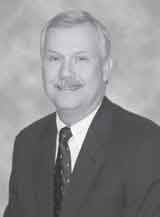From the Executive Director – March 2006
 Challenges
ChallengesIn this issue of JSHAP, the "Straight talk" feature asks members for their "everyday challenges facing swine veterinarians." Reading this column sparked my reflection on the challenges facing an association such as AASV. I have been with the AASV since 1994 and have been writing this message since the May-June 2000 issue. As part of my reflection, I looked back at that first message1 written 6 years ago.
The first thing I noticed was how dark my hair was back then. Perhaps as a prediction of things to come, I made this statement in my message: "Now comes the part that sometimes turns my hair gray: How does the AASP continue its success?" Look at my current photo and you will see that my hair is now gray and not just sometimes! Putting my maturing vanity aside, I think that the question is still pertinent and challenging: How does AASV continue its success?
In my inaugural message, I listed the following drivers for the future success of AASP, soon to be AASV:
- Ensuring that the right people are in the right place at the right time.
- Providing resources to do what needs to be done.
- Allowing younger members to assume leadership roles.
- Keeping long-time members engaged and accessible.
- Maintaining a "lean and mean" organizational structure, staff, and office.
- Segmenting the membership to ensure that all needs are adequately met.
- Surpassing the expectations of all who interact with the AASP.
- Providing the best education, information, networking, and advocacy for swine practitioners.
I don’t remember receiving any feedback on the accuracy or completeness of my list at the time I wrote this. That’s one of my challenges: knowing whether anyone reads my column. Just as then, now you can be the judge on how I have done in my listing as well as the level of success of AASV. Improvement is almost always needed and many challenges remain. An association such as the AASV cannot afford to stay still for long. In order for the AASV to be successful, we must pursue continual improvement in the areas that are valued by our members and potential members.
Remarkably, over the last 6 years, the veterinary medical profession and the pork industry have continued to change and evolve. New drivers for success have emerged. The AASV mission is now achieved under somewhat different circumstances and conditions. I see the following as emerging drivers for success of the AASV:
- Recruiting and educating future generations of swine veterinarians.
- Communicating an accurate and positive message about swine veterinary medicine and pork production to multiple audiences.
- Maintaining a meaningful presence within organized veterinary medicine.
- Curtailing the marginalization of food animal veterinarians by anti-agriculture activists and other professions.
- Demonstrating and increasing the value of veterinary services to our clients, regardless of their magnitude of production.
One of the greatest challenges I face is balancing that which is immediate with that which is important. They are not always the same. In the AASV office, there are always tasks that need immediate attention. Invoices need to be paid, meeting rooms assigned, e-mails answered – the list goes on and on. Immediacy, however, is typically limited by a tangible endpoint. You know when you have completed the task at hand. It is way too easy to spend time taking care of immediate needs or the "busy work." The challenge is to take time to consider what is truly important for the association. This may lie well beyond the immediate tasks at hand and requires a view well beyond the horizon to which you have become accustomed. It requires a conscious effort and may in fact cause discomfort for some. Fortunately, the AASV has volunteer leadership and a strong core of members who are willing to engage in the discussion and discernment of that which is important over the long haul.
The challenge does not end with the discernment and discovery of the important long-term needs of the AASV, its members, the veterinary medical profession, and the pork industry. The challenge continues in matching resources with motivation and ingenuity while maintaining a focus on our mission. Eventually, if done right, the tasks at hand result from the understanding and vision of that which is important. Then when challenges arise, that which is important will drive that which is immediate.
Reference
1. Burkgren T. From the Executive Director. Swine Health Prod. 2000;8:104.
— Tom Burkgren